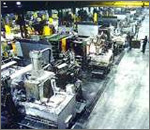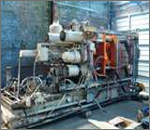Hot chamber machines or hot chamber die casting machines are used primarily for zinc, copper, magnesium, lead and other low melting point alloys that do not readily attack and erode metal pots, cylinders and plun

gers. The injection mechanism of a hot chamber die casting machine is immersed in the molten metal bath of a metal holding furnace.
The furnace is attached to the hot chamber machine by a metal feed system called a goose neck. As the injection cylinder plunger rises, a port in the injection cylinder opens, allowing molten metal to fill the cylinder.
As the plunger moves downward it seals the port and forces molten metal through the goose neck and nozzle into the die cavity. After the metal has solidified in the die cavity, the plunger is withdrawn, the die opens and the casting is ejected.
History: The earliest examples of die casting by pressure injection - as opposed to casting by gravity pressure - occurred in the mid-1800s. A patent was awarded to Sturges in 1849 for the first manually operated machine for casting printing type.
The process was limited to printer’s type for the next 20 years, but development of other shapes began to increase toward the end of the century. By 1892, commercial applications

included parts for phonographs and cash registers, and mass production of many types of parts began in the early 1900s.
The first die casting alloys were various compositions of tin and lead, but their use declined with the introduction of zinc and aluminum alloys in 1914. Magnesium and copper alloys quickly followed, and by the 1930s, many of the modern alloys still in use
today became available.
The Future: Refinements continue in both the alloys used in die casting and the process itself, expanding die casting applications into almost every known market. Once limitedto simple lead type,
today’s die casters can produce castings in a variety of sizes, shapes and wall thicknesses that are strong, durable and dimensionally precise.


